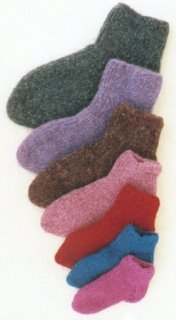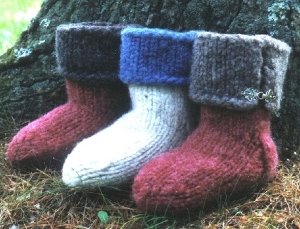GET FELTED - Fulling Tips from Dawn Brocco
I read Dawn Brocco's blog every single day and have done so for a few years now. (We "outer borough" girls have to stick together.) Dawn is a knitwear designer (Dawn Brocco Knitwear Designs - you've seen her designs in the Patternworks catalog among other places) who shares peeks into the design process and her life at Dawn Brocco's Life and Design Blog and I highly recommend you pop over and see what you've been missing. 
Dawn was kind enough to put together a fulling/felting primer for us.
From Dawn :
We all know the basics - only protein fibers full, bleached white wool won't necessarily full, and fulling occurs more in the length than the width.
I use the word fulling, as felting pertains only to a non fabric process, as in using fleece or batting. Fulling refers to the process as it applies to fabric - whether a woven, knit or crocheted fabric. If you are shrinking any kind of protein-fiber fabric, you are fulling it, not felting it.
Now, when choosing a yarn for a fulling project, the degree of fulling that will be done affects the choice of yarn.
For a light fulling - basically a tightening up of the fabric - even rustic, coarser wools or wools with guard hairs will oblige.
For a dense, can't-see-the-sts-any-longer fulling, you will want to choose yarn more carefully.
In my fulled designs, I'm not aiming for a dense fulled fabric that resembles a felted fleece fabric. I prefer just a tightened fabric that still resembles knitting.
Variables to consider when choosing a yarn to full with:wool breed (if wool, not mohair, alpaca, etc)the density of the spin and plythe style of spinning in the yarn
Softer breeds of wool with shorter fibers can full better/faster than coarser breeds with longer fibers.
Looser plied yarn can full faster than tightly plied yarn.
Woolen spun yarns can full better than worsted spun yarns. What's the difference? Worsted spun yarns are smooth and dense. The fibers have been combed to align them before spinning. Woolen yarns are carded. The fibers are mixed up more willy nilly before spinning, making the yarns loftier and fuzzier.
When you consider a yarn, remember that fulling requires air space, not just within the fabric, but also within the yarn. Fibers that are showing more surface area are providing the ideal environment in which fulling can occur.
Think softer, rather than harsher, yarns with air space/surface area, when choosing a yarn for fulling.
Thanks, Dawn, from all of us at RTY!
(The top photo is Dawn's Fulled Family Booties. The bottom photo is Dawn's Toasty Toes.)

Dawn was kind enough to put together a fulling/felting primer for us.
From Dawn :
We all know the basics - only protein fibers full, bleached white wool won't necessarily full, and fulling occurs more in the length than the width.
I use the word fulling, as felting pertains only to a non fabric process, as in using fleece or batting. Fulling refers to the process as it applies to fabric - whether a woven, knit or crocheted fabric. If you are shrinking any kind of protein-fiber fabric, you are fulling it, not felting it.
Now, when choosing a yarn for a fulling project, the degree of fulling that will be done affects the choice of yarn.
For a light fulling - basically a tightening up of the fabric - even rustic, coarser wools or wools with guard hairs will oblige.
For a dense, can't-see-the-sts-any-longer fulling, you will want to choose yarn more carefully.
In my fulled designs, I'm not aiming for a dense fulled fabric that resembles a felted fleece fabric. I prefer just a tightened fabric that still resembles knitting.
Variables to consider when choosing a yarn to full with:wool breed (if wool, not mohair, alpaca, etc)the density of the spin and plythe style of spinning in the yarn
Softer breeds of wool with shorter fibers can full better/faster than coarser breeds with longer fibers.
Looser plied yarn can full faster than tightly plied yarn.
Woolen spun yarns can full better than worsted spun yarns. What's the difference? Worsted spun yarns are smooth and dense. The fibers have been combed to align them before spinning. Woolen yarns are carded. The fibers are mixed up more willy nilly before spinning, making the yarns loftier and fuzzier.

When you consider a yarn, remember that fulling requires air space, not just within the fabric, but also within the yarn. Fibers that are showing more surface area are providing the ideal environment in which fulling can occur.
Think softer, rather than harsher, yarns with air space/surface area, when choosing a yarn for fulling.
Thanks, Dawn, from all of us at RTY!
(The top photo is Dawn's Fulled Family Booties. The bottom photo is Dawn's Toasty Toes.)







7 Comments:
Great tips! Here's a question for Dawn or anyone else who can help me out: My washing machine doesn't have an agitator. It takes me a good 4-5 cycles to get something to felt even a little bit. Any suggestions on what I can do to improve my non-agitating washer's felting action?
Hi Sharon,
I don't use my washer for fulling. I do wash the item with a load of clothes on the warm water setting, but it's the dryer I use to do the real fulling. Permanent press cycle with a couple old towels or jeans, checking every few minutes - no walking away!
If after several checkings, it's not shrinking enough, but is nearly dry, I resoak the item a few minutes, wring it out, turn it inside out and put it back in the dryer, again, checking every few minutes.
HTH!
I always thought I was felting....I didn't know I was actually 'fulling'. Learn something new everyday.
Thanks Dawn! That is a huge help. Now I can't wait to start my first project and get my dryer fired up for fulling.
Dawn, now I'm both intrigued and confused. (My usual state!) If you actually dry the fulled object in the dryer, how can you block it into shape for box or bowl shaped items? I thought hot water, alkalinity, and agitation created the initial shrinkage (with apologies to Seinfeld) and that shrinkage was either heightened or locked in with the rush of cold water.
Does the dryer work best with the lightly fulled objective or will it also work if you want to completely obliterate stitch definition?
Barbara asks:"If you actually dry the fulled object in the dryer, how can you block it into shape for box or bowl shaped items? I thought hot water, alkalinity, and agitation created the initial shrinkage (with apologies to Seinfeld) and that shrinkage was either heightened or locked in with the rush of cold water.
Does the dryer work best with the lightly fulled objective or will it also work if you want to completely obliterate stitch definition? "
The item isn't fulled when it comes out of my washer. That one trip through the washer is just to get it clean and thoroughly wet.
But here's the thing - I'm frugal, I don't wash (in the washing machine) with hot water, ever. I only wash with lukecool (not even lukewarm!) water and same temp rinse, so there's no change in water temp from washing to rinsing. It may look a little bedraggled at this point, and maybe a smidge shrunken, but definitely not done.
So I won't run a special load just to full something. It gets washed and dried with my laundry. 2 birds, one stone. I *say* old towels or jeans, as that's the usual recommendation, but actually, I dry the item-to-be-fulled with my usual laundry loads, which include clothing and towels. (There's just 2 of us now - not enough clothes to keep it all separate!)
I'll also handwash the item, then spin out the washer in the spin only cycle of the washer, then toss into the dryer.
So, for things that need shaping - like hats, I often find, that the item is still damp when it's fulled to the size I desire, whether from the first trip through the dryer or after having to rewet the thing. I never dry the dickens out of an itme that I'm fulling! I *always* pull it out while still damp, then shape the thing and let it air dry.
As for complete obliteration - I've very fulled some handwoven shetland wool yardage and some small wool knit blankets, that belong to Pickles". 1 trip through the washer and then into the dryer.
Each time I wash and dry the things, they shrink a bit more, BUT, they were not knit/woven with the intention of being fulled, as in they were not knit/woven more loosely than usual.
If they had been, I bet the sts would have become obliterated far sooner.
I haven't done a thorough testing of the fulling-in-dryer method, like those that have written felting books might have done (don't know - don't have any of those books). I've just done what I needed to in a way that was economical and made logical use of the machines in the way I use them.
As I think about it, I wonder if the hot water/cold water/soap and agitation method isn't a carryover from felting? Where when dealing with fleece or wool batts, this is the method used, as one can't just toss a layer of wool batts into the dryer!
And it might be that felting wool batts is an older art than felting knitting - just a supposition, I really have no idea. But it would then make sense that this traditional method would be used, but with the modern twist of employing the washer, instead of a scrub-board by hand, as one would do felting with fleece/batts.
I'm just outside the box, I guess!
Does this help?
Dawn, THANK YOU! It not only helps, it's fascinating too. I'm a cool/lukewarm wash type also so when I attempt to full/felt, we have to go down to the basement, raise the water temp, etc., etc. And I still don't get the look I'm hoping for most of the time. I think I'm going to try the dryer method and see what happens.
Post a Comment
<< Home